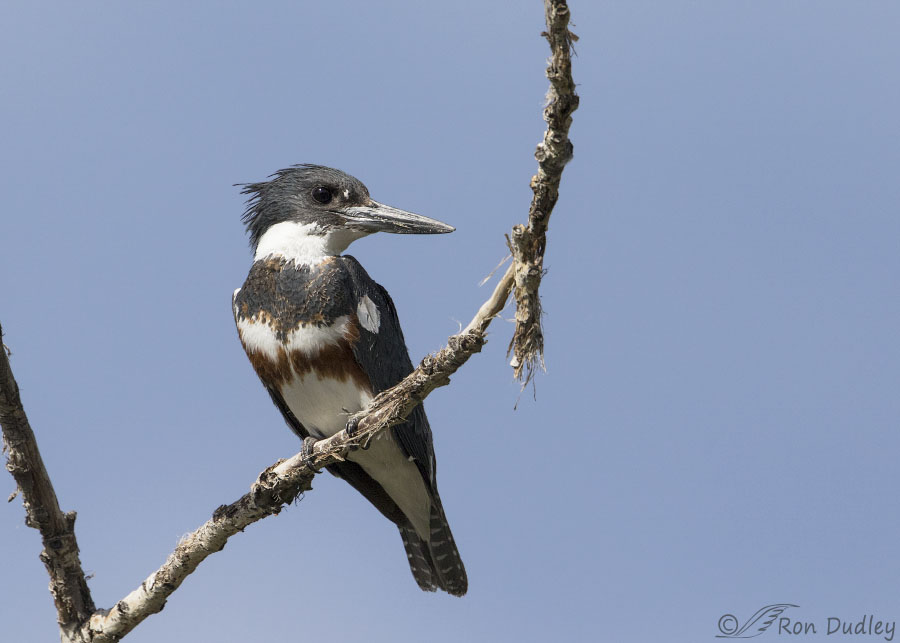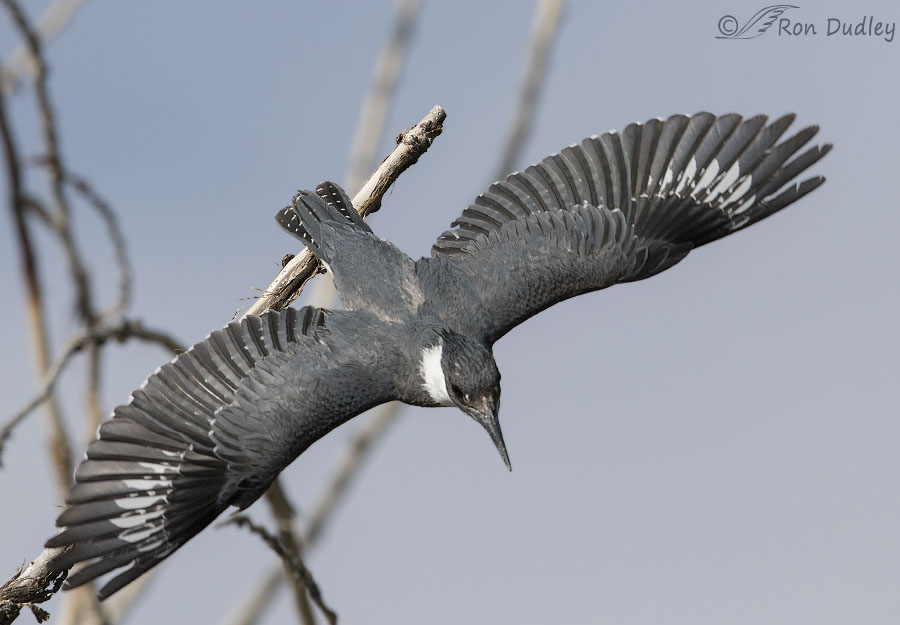Kingfishers diving from their fishing perches are among the most difficult photos I’ve attempted to get. It can be done but doing it well is another matter. There are just too many things that can and do go wrong including clipped body parts, eyes that are hidden or in shade, soft birds, backgrounds extremely cluttered with branches and blown exposures. In this situation Murphy’s Law rules for me.
And clipped body parts are the primary offender – kingfishers take off after fish in a blindingly fast power dive and it’s usually impossible to anticipate so clipped or cut off wings or “air shots” are the rule rather than the exception.

1/4000, f/7.1, ISO 500, Canon 7D Mark II, Canon EF 500mm f/4L IS II USM + EF 1.4 III Extender, not baited, set up or called in
Two days ago I finally found some more kingfishers. There were two of them, a male and a female, who may or may not have been mated. It was midafternoon so the light was still harsh but I was so excited to find them I simply had to take a few shots just for old time’s sake.
This is the female and I only had a couple of minutes with her on two different perches. I chose to post her on this perch because it had a clean background – the other one was a mess of jumbled, out-of-focus branches. Largely because of the harsh light and shadows it isn’t a great photo but hey, it’s a kingfisher up close so I was happy to get it.
But what I really wanted was a high quality takeoff/diving shot.

1/4000, f/7.1, ISO 500, Canon 7D Mark II, Canon EF 500mm f/4L IS II USM + EF 1.4 III Extender, not baited, set up or called in
Five minutes later when she dove (dived? – there’s that quandary again) after a fish from the more cluttered perch I came close but no cigar. When I saw her concentrate her gaze on a spot on the water below her I fired off a burst just before she launched and got one shot with all of her in frame. I was lucky to not clip anything because this is a small crop and almost full frame horizontally. I especially like the well-lit look at her entire dorsal surface where we can actually distinguish each individual flight feather.
In an action shot like this one the branches in the background don’t bother me so much but we can’t really see her eye and her head could be sharper and in my view those are significant faults.
So my attempt at getting quality kingfisher takeoff/diving shots is still a work in progress but I thought I’d provide readers a progress report of sorts.
And I’ll admit that the quest is almost as much fun as success.
Ron
PS – I promised I’d keep readers updated on the nesting Mourning Doves outside my window and for this bird photographer the news isn’t good. I haven’t seen them since they completed the nest so they must have gone elsewhere to raise their family. I suspect they did so because of all of the hubbub from my neighbors who often have to pass almost directly beneath the tree or perhaps it’s because the catalpa leaves in the nest tree come out so very late. The nest is still in full sunshine in the afternoon and it’s been unusually hot for the past few days.


Dove and dived are both acceptable as past tense for dive, however dove is the most common usage in North America, while dived is the most common usage outside of North America.
Finally back on land and with Internet service – hooray!! Nice to see a Kingfisher for my first post back. Love the action shot. I had no trouble seeing her eye. And I’m always happy to see Kingfishers.
Welcome back, Susan – we’ve missed you. That must have been a wonderful long trip and you seem to do it every year. I hope you had a spectacular time while you were gone.
LOVE that last shot! I never realized their tails had that dashed pattern. (I still say that “diven” should be the past tense of dive!) 😉
Alas, I think your Mourning Doves and my Mourning Doves must have received the same memo. I haven’t seen my pair for the past several days. 🙁
Ha, a third option for that word! And knowing me that’s the one that will come to mind!
Sorry about your doves, Marty. I know the feeling…
Ron, you’ve said many times how difficult it is to photograph Kingfishers but here you’ve had some successes. It sounds like getting a diving shot is a very big challenge and if you get one, you are quite fortunate.
I’m sure you miss not seeing the Mourning Doves as you had high hopes about seeing things transpire from your computer desk. At least you had the thrill of seeing the nest initially and hope the birds/eggs are ok.
Thank you, Ron
Yup, it’s a start with that kind of shot, Alice. I hope I have more chances with them but with kingfishers you never know.
All of my life is a work in progress.
I am sorry that the Mourning Doves moved away and hope they have success where ever they nest.
I am awed by that wing spread, and do understand your pickiness. I am glad that you like the shot anyway.
My life is too, EC. But sometimes the progress is agonizingly slow or in the wrong direction.
I love it, nits to be picked and all! I love it that you have so many quests to perfection. They will keep you going for a long time. YAY!
I’ll never run out of photographic goals that have remained elusive, Laura!
Awesome Ron!
Charlotte
Thanks, Charlotte.
Ron,
I think it is a great shot. You are waaaayyyy too critical on yourself, but that standard is why your shots are so great!
Stephen
Stephen, I like it too but not being able to see the eye is just a little too much for me…
Disappointing about the mourning doves…was hoping,mas youbwere, to follow them as they raised their young…beautiful, wide-wing shot of the “Queen” fisher, though…:-)
Me too. Thanks, Patty.
A haiku inspired by bird and photographer
wiith wings spread so wide
magnificent symmetry
such skill and patience
🙂
Love it!!!
Good job with the kingfishers, Ron. They are definitely hard. I’ve yet to get a decent photo of one diving.
Thank you, Nancy.
Nice shots! I completely agree that these guys just don’t cooperate for photos. Whenever I see one it almost always bolts immediately with no fish grabbing show. VERY illusive to photograph.
They truly are. Thanks, Dave.
Ron, Do a google search for diving kingfisher photo and you should find a photographers post of his 6 year/720K photo effort to capture that shot. I have been following your blog, and Mia’s also, since learning about you a few months ago. I have enjoyed your photography and the stories behind the shots,
Thanks for the kind words, Ken. I’ve seen that post previously but I’m afraid I’m not a fan of setup shots, no matter the inherent difficulty.
Love this latest installment of your ongoing quest for excellent Kingfisher photographs! They look really nice to me and I can certainly appreciate the difficulty in photographing these birds. The only photos of I have of Kingfishers are from such a distance they appear to be just dots in the sky. Thanks.
Thank you, Joanne.
Good morning Ron. Great shots of one of the most difficult birds to photograph. Just finding one in a pose is a miracle in itself. And then when you do you often have no more than 60 seconds to get off a shot. And trying to get one diving into the water for a catch would require the patience of Job. Beautiful photos.
Everett Sanborn
Prescott AZ
Yup, you get it, Everett. Diving kingfishers are a bundle of challenges.
Great images Ron! Kingfishers are such beautiful birds when you see them like this!
Thank you, Ed.
Gosh would you believe I am up on the web and saw your post come thru. I get to be one of first people to post!! Very nice pictures. I am like most and only hear and see them fly by so fast. Now I am going back to bed for an hour or two. Ha Ha Have a good day Ron.
And a good (very early) morning to you, Trudy! I hope you can get some more sleep. Thank you.
WOW! Good Job! (How are the Mourning Doves?)
Good question, Melanie. I’ve provided the answer in an edit at the bottom of my post.
Sad news that the nest was abandoned. Guess it was too well-built! LOL! Your idea that the nest was too exposed is a good one. Mourning doves often nest in pines in NC … perhaps because they are evergreens.
I’ll take it! 🙂 Glad you found a pair and were able to get some shots!
It’s a beginning. Thanks, Judy.